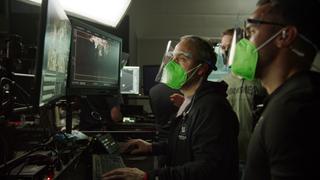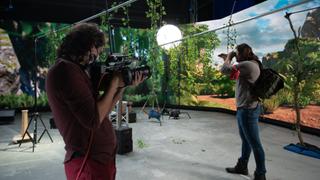New Cameras, LED Walls Are Game Changers for Production
The potential to reduce VFX time and costs is a big one

Virtual production techniques have a long history in Hollywood but have really exploded in popularity in the last two years, thanks to travel restrictions during the pandemic and a host of tech improvements.
Boom time: Much of the current interest stems from the use of large LED walls and gaming engines to create the fantastic virtual worlds seen in “The Mandalorian.”
“When we did ‘The Mandalorian,’ we used off-the-shelf technologies like the Unreal game engine that were created for games, not TV production,” said Greig Fraser, who won a Primetime Emmy Award for Outstanding Cinematography for his work on the Disney+ original. “Now you have technologies that are purpose-built for virtual production with many more capabilities. We’re still in the early days but the [upcoming] release of Epic Games’ Unreal Engine 5 will be a game changer.”
Many others agree: “There are hundreds of stages going up around the world and we’re directly involved in dozens of them already,” said Adam Schmidt, executive vice president at Planar, a supplier of LED panels that recently launched a virtual production initiative Planar Studios.

Gaming engines drive new production capabilities: “What is really exciting is [how] the film industry [is starting] to truly understand the power of game engine technology in the context of world-building,” explained Miles Perkins, industry manager of film and television at Epic Games. It recently released a new version of its gaming engine, Unreal Engine 4.27, with the highly anticipated full release of 5.0 set for early 2022.
The 4.27 includes a host of new features designed to improve “quality, efficiency and ease of use” for virtual productions, Perkins said.
“When Epic Games releases the full version of Unreal 5, the current limits imposed on the cinematic architecture will be lifted, allowing for more realism,” said A. J. Wedding, co-founder of Orbital Studios.
Get the TV Tech Newsletter
The professional video industry's #1 source for news, trends and product and tech information. Sign up below.

Final pixel shooting: “The ability to shoot basically anywhere without travelling to that location was the primary driver” of interest in virtual productions early on but as the technology has improved, “the potential to reduce VFX time and costs is a big one,” explained Sean Sheridan, regional technical manager for the Americas at Brompton Technology, which has emerged as a major player in the virtual production tech space.
That is improving the image quality of video shot of actors in front of LED walls without a lot of post-production work. “Final pixel-shooting [is] really hot,” added Michael Geissler, CEO at Mo-Sys Engineering, which recently released the VP Pro 4.27 software that has been used on virtual productions for Amazon and Netflix.

Expertise is as important as technology: NEP, which recently launched its NEP Virtual Studios with the acquisition of Prysm Collective, Lux Machina and Halon Entertainment, has made providing production expertise a central part of their strategy, explained Zach Alexander, co-president of Lux Machina NEP Business unit at NEP Virtual Studios.
To help the industry cope with the complexities of a virtual production, SMPTE has embarked on a high-profile virtual production initiative. “It has become very, very clear that education is a big obstacle, not only among professionals wanting to use the technology but in terms of training people to handle virtual productions,” said Kari Grubin, a consultant who is spearheading the project, which is focusing on such areas as interoperability, best practices and education.
Educators are also getting involved. Sheridan College’s Screen Industries Research and Training (SIRT) Centre in Toronto, for example, has built a new Virtual Production Innovation Hub. “We really want to be a sandbox where creatives can advance the technologies and better understand how they can use it,” said SIRT production lead Jason Hunter.

New cameras shoot new virtual worlds: More innovation is coming from traditional vendors of production tech. The SIRT Center, for example, relies on a number of technologies from Blackmagic Design, including the URSA Mini Pro 12K.
ARRI has also jumped into the virtual production sector in a big way. It created some smaller experimental stages in Munich and Burbank to integrate their products into those from other companies and launched a new virtual production studio in U.K. in the summer of 2021. The ARRI solutions group also worked with the German production company to set up a virtual production stage in Berlin.
© NAB 2021
George Winslow is the senior content producer for TV Tech. He has written about the television, media and technology industries for nearly 30 years for such publications as Broadcasting & Cable, Multichannel News and TV Tech. Over the years, he has edited a number of magazines, including Multichannel News International and World Screen, and moderated panels at such major industry events as NAB and MIP TV. He has published two books and dozens of encyclopedia articles on such subjects as the media, New York City history and economics.

